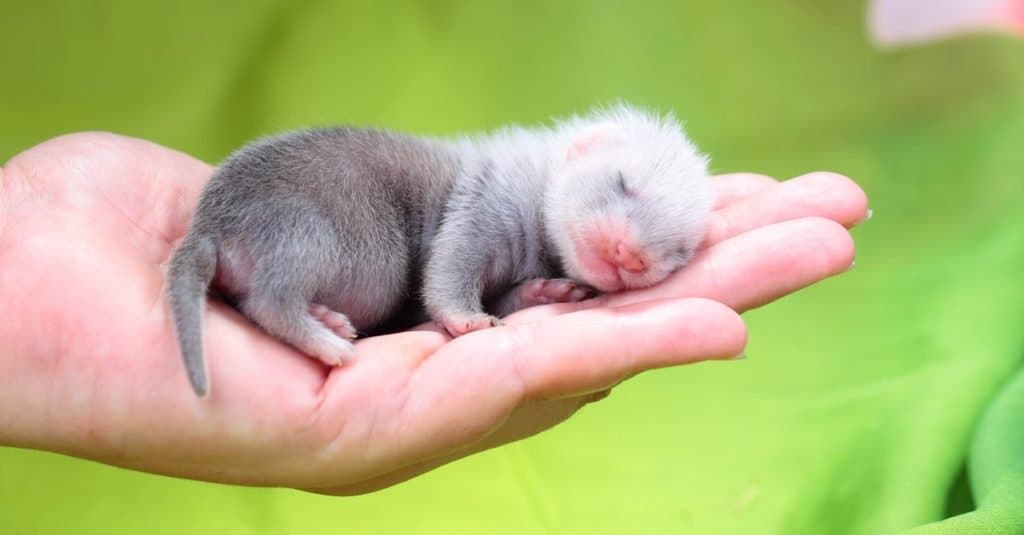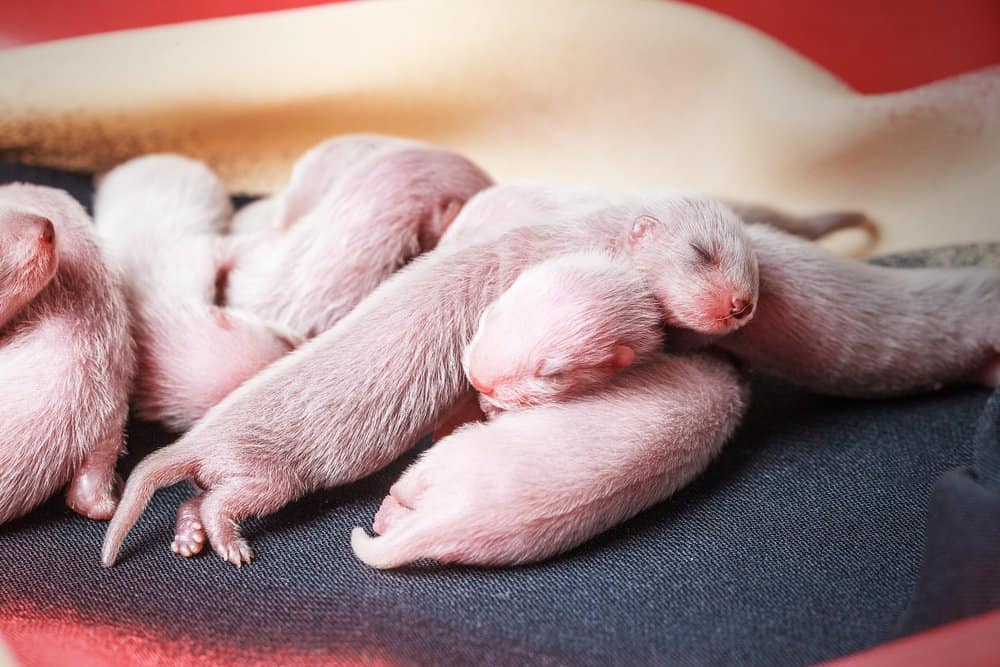We can’t deny it—babies are adorable! Baby ferrets? So much cuteness!
Ferret babies are typically born in litters of 4-8. The first weeks of life are precarious, as it’s difficult to hand-feed the babies if something goes wrong. They begin eating meat at just three and a half to four weeks old and can be adopted at eight weeks of age.
Whether you’re thinking of adopting baby ferrets of your own or are just curious about these fun animals, you can learn more below. We’ll discuss everything about ferret kits from birth to settling a baby ferret into your home.
What Do You Call A Baby Ferret?

Baby ferrets are known as kits.
©Denis Kukareko/Shutterstock.com
Baby ferrets are called kits until one year of age. Intact males are then called hobs, and females are referred to as jills. Neutered males are gibs, while spayed females are sprites.
How Many Babies Do Ferrets Have At Once?
Ferrets have average litters of 4-8 kits. Some jills give birth to just one kit, while others may have as many as fourteen in the same litter! Average litter sizes are ideal because mother ferrets have only five to nine nipples. Only this many kits can nurse at once, so a jill with a large litter will move some kits behind her to force them to take turns.
If you’re caring for a jill and her kits, it’s important to weigh the kits regularly to ensure they’re gaining weight. A jill with too small of a litter might stop producing milk, and you will have to hand feed all of her kits. This can be difficult or even impossible to do, depending on the age and size of the kits. We recommend consulting your veterinarian the moment you notice a lack of milk production in the mother or a lack of weight gain in the kits.
What Do Baby Ferrets Eat?
Baby ferrets nurse from their mother. If a jill stops producing milk or a baby kit doesn’t get enough to eat, this can, unfortunately, mean death for the babies. They are difficult to hand feed at this young age.
Weaning begins between three and a half and four weeks. Kits are fed mushy food like ground meat, broth-soaked kibble, and soft kitten food. Kits are messy eaters at first, a lot like human babies. They’re fast learners, however, and it takes only a few days for them to master this new skill! Kits are completely weaned by six weeks of age and lose their baby teeth by the time they’re ten weeks old.
Ferrets cannot digest non-meat items like fruits, veggies, and grains. Their food should be free of these fillers and contain high amounts of protein, fat, and fatty acids.
Unfortunately, pet stores are allowed to sell items, such as foods and treats, marketed toward animals they aren’t suited for. This makes it crucial that you do your research to keep your baby ferret healthy. Checking the ingredient list is number one. Look for meat listed as the first ingredient and a lack of the fillers listed above.
What Age Can Baby Ferrets Leave Their Mother?

Kits rely on their mothers for food until six weeks of age.
©Rashid Valitov/Shutterstock.com
Newborn ferrets depend on their mothers for everything, from nursing on her milk to going potty! She seems to take this job seriously and knows when a kit is missing. Of course, not all ferrets make good mothers—but many are even willing to nurse another ferret’s kits with no problem.
Ferrets begin the weaning process at three and a half weeks old and are completely weaned by six weeks old. They’re ready to leave their mother and siblings at eight weeks of age. They must get this time with their mother and siblings unless it’s absolutely impossible, such as in the case of orphaned kits.
Never purchase a ferret from a breeder who allows you to adopt before eight weeks—this is a sign that they are not a reputable breeder and care more about profit than their ferrets’ wellbeing.
How Much Do Baby Ferrets Cost?
The amount a ferret costs depends on where you adopt it. You can find plenty of people rehoming their ferrets for free, while rescues and shelters typically charge $50-$150 as an adoption fee. This helps them continue to take in and care for animals. Reputable breeders charge upwards of $100-$500.
If you don’t already have a ferret, double these costs—they are social animals that must be raised in either pairs or groups. Under no circumstances should you adopt a ferret from a pet store. Most big chain stores get their ferrets from Marshall, a ferret mill that produces ferrets en masse. They aren’t transparent about their breeding practices, and this is almost because the ferrets in their care aren’t well cared for. Animal mills only care about profit, not the animals’ wellbeing.
Ferret mills are why so many ferrets in the United States are unhealthy and live shorter lifespans than ferrets bred overseas. Even with small chain pet stores, you cannot vet the breeder appropriately. Don’t trust the pet store to do the right thing—instead, find a reputable breeder yourself or adopt from a rescue or shelter. You’ll know a breeder is reputable if they have a waiting list, charge significantly (cheaper isn’t better when it comes to breeders!), and know the animal inside and out.
Ferret breeding is dangerous for the ferrets involved, especially when the breeder is inexperienced. Plenty of complications can arise, including the death of a jill who isn’t bred while in season. Reputable breeders should allow you to see where the ferret kits and parents are raised, provide adequate free roam space for their ferrets, and show copies of veterinary paperwork, including vaccine records.
Other Costs
Of course, the money spent on your ferret is just the beginning. Once all of your other costs add up, even $500 will seem cheap!
Start-up costs for ferrets include:
- A large, multi-story cage
- A carrier to bring your ferret home in and for future veterinary appointments and travels
- Toys and other enrichment items
- Water and food bowls (not a water bottle)
- High-quality ferret food
- A shallow litterbox large enough for your ferrets to stand in completely
- Ferret-safe litter (not clay or clumping cat litter!)
- Bedding for your ferret’s cage
- A veterinary check-up for each ferret
- Vaccinations (your breeder should have already provided a distemper vaccine, but your ferret will need a rabies vaccine at 12 weeks old)
- Spay or neuter surgery for your ferrets if they haven’t had the procedure already
Lifelong costs include:
- A high-quality ferret food
- Ferret-safe litter
- Enrichment items to keep your ferret entertained
- Cleaning supplies including detergent to wash bedding
- Replacement toys, bedding, and other objects that receive wear and tear or damage from destructive chewing
- Routine veterinary care
- Emergency veterinary care (savings or pet insurance)
Remember that ferrets must see an exotic pet veterinarian, not a dog and cat vet. Because they are specialists, exotic pet vets are typically more expensive.
Find a veterinarian that specializes in exotic animals before bringing your ferrets home. This way, you know there’s one in your area and that you can provide your ferrets the best possible lives.
It is also advised to look into emergency care ahead of time. Call around to emergency veterinarians near you to see if they treat ferrets, since some don’t, and save their phone numbers and addresses in your phone. You’ll thank yourself in case of an emergency later on!
How Do You Bond With Baby Ferrets?

Baby ferrets’ body language should be understood for bonding purposes.
©Rashid Valitov/Shutterstock.com
The first thing you should do before adopting your ferrets is to learn their body language. This will help you bond with them well.
Reading Ferret Body Language
Some things to keep in mind include:
- Happy, playful ferrets will keep their head up, alert. They may run, jump, pounce, and act silly. “Dooking” is a noise made by happy ferrets that’s wonderful to hear. Your ferret may run after you or invite you to chase them by backing away playfully!
- Begging ferrets might stare at you until you give them what they want, such as playtime or a treat. They might play with their bowls if they’re hungry as well!
- Fearful ferrets might cower, hide, hiss, or yell.
- Sick or injured ferrets lie flat with their eyes squinted. They might sleep more often, become lethargic, or just act differently to their day-to-day selves.
Bonding With Your New Ferret
Next, you’ll want to give your ferrets at least six hours daily free roam time. This is required throughout a ferret’s life and will also help you bond with them. During free roam, you can let your ferret follow you around, involve them in what you’re doing (such as talking with them or having them nearby), and play with them!
Play is incredibly important for ferrets, and you should be spending about two hours a day actively playing with your ferret. Try using toys on a stick, like cat wand toys; things you can toss, like balls; and tunnels to satisfy their burrowing instinct. When you’re first getting to know your baby ferret, offer them treats for interacting nicely with you. It can be a sniff of your hand or playtime with no biting. This helps your ferret associate you with good things.
Training your ferret will also help the two of you bond. You’ll feel so proud of your ferret when they get something right, and they’ll love the attention throughout, as well as the praise and treat at the end! Start with litter training since it’s incredibly important for a ferret to know. Then, you can work your way up to going to the cage on command, allowing you to touch their feet for nail trims and even less practical tricks like rolling over on command.
Training is best done one-on-one when your ferret is at a moderate energy level. It should have some playtime outside of its cage first, but not enough that it’s ready for a nap.
Remember to keep training sessions positive and short. Never punish your ferret by yelling, hitting, or kicking—this will worsen your relationship and doesn’t have any positive side. Your ferret won’t learn anything through harsh punishments or abuse!
Growing Up: Stages Of Ferret Development
| Female Weight | Male Weight | |
|---|---|---|
| Birth | 8-12 grams | 8-12 grams |
| 8 weeks | 300-500 grams | 400-500 grams |
| 16 weeks | 600-900 grams | 1000-2000 grams |
| 4 months | 1-3.5 pounds | 2-3.5 pounds |
| 10+ months | 1.5-3 pounds | 3-5 pounds |
Ferret babies are born defenseless with no sight, hearing, or teeth. They can make sounds and often “talk” to their mother if they squirm too far away from her or are hungry. They’re already quite active at this age, wriggling around frequently and eating every few hours. However, they also sleep a lot!
Four weeks of age is a huge milestone for kits. They now have baby teeth and can eat solid foods. They can also use the bathroom independently and should start litter training. At four to five weeks of age, ferrets will also open their eyes and gain the ability to hear. They also begin to play, though they’ll be clumsy and slow-moving at first!
Kits are adoptable at eight weeks old. They’re fully grown between six and ten months but still considered kits until they turn a year old.
Health Problems In Ferrets
Kits from pet stores tend to have more health problems since they weren’t bred responsibly. Things to look for include:
It’s important to monitor your ferret well and give it frequent health checks. Look for changes in behavior, rapid weight loss or gain, fur and skin health, discharge from the eyes, nose, or ears, sleeping patterns, and litter habits. Our ferrets’ poop can tell us a lot about them as well. Note the normal shape and size so that you know if it ever looks unusual.
Lastly, blindness and deafness can be common in ferrets who are poorly bred. Blind ferrets may have difficulty navigating changes in their environment. Deaf ferrets often have white coats with dark eyes or a panda or striped pattern on their fur. Luckily, ferrets don’t depend on their eyesight much. Their hearing, however, is more strongly developed.
Ferrets can live both blind and deaf, which isn’t considered a major health problem for them—it just requires some accommodations!
The photo featured at the top of this post is © Rashid Valitov/Shutterstock.com
Thank you for reading! Have some feedback for us? Contact the AZ Animals editorial team.






